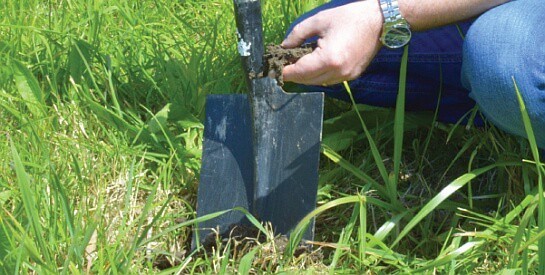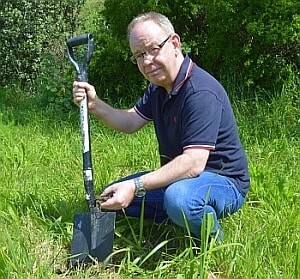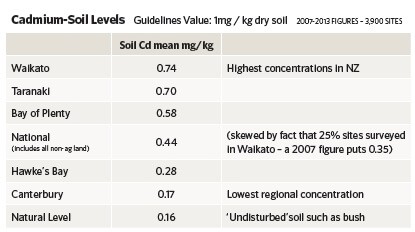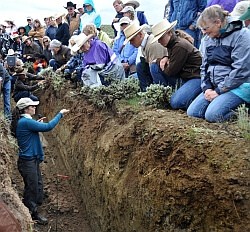Cadmium is a heavy metal, found naturally in minuscule amounts in soil, air and water, but at concentrated levels in phosphate, which is used in fertilisers. And we are a country driven by superphosphate. Every year roughly two million tonnes of the stuff is added to our land to boost agricultural productivity, leading to a ‘negative banking’ of cadmium (not to mention fluoride and uranium).
While some cadmium is assimilated – taken up by plants, ingested by animals – and leached into waterways, most accumulates in the soil year on year.
Cadmium (Cd) is toxic to kidneys, causes bone demineralisation and has been classified as carcinogenic to humans. Due primarily to phosphate applications, it has become pervasive at elevated levels throughout our food chain, with starchy root vegetables, leafy greens and cereals, such as wheat, showing significant traces, through to meat, animal organs and shellfish.
In the past, New Zealand had access to relatively cheap and plentiful phosphate rock from Nauru, which also contained some of the highest rates of cadmium in the world. Since the alarm on cadmium was raised in the 90’s, we’ve been sourcing phosphate from places like Morocco, which has helped to lower cadmium quantities in superphosphates by 40%. But cadmium levels are still a worry, both here and overseas, due to historic accumulation and the ongoing use of fertiliser.
National cadmium strategy
While the nationally formed Cadmium Working Group reported in 2008 that soil Cd levels in New Zealand posed no risk to health, the real concern was threat to international trade, with sensitive export markets, like the EU, setting lower levels of tolerability.
Other export markets, including China and the US, are also increasingly alarmed at cadmium absorption into food. In China, where the term ‘cadmium rice’ has arisen, a recent report noted that cadmium levels had risen 50% in the southwest and coastal regions since studies in 1990; 10-40% elsewhere. In the US, cadmium is described as the ‘new lead’ because of its increasing presence in foods and studies linking cadmium to learning disabilities in children.
NZ’s Cadmium Working Group has given a guideline value of 1mg Cd per kilogram soil, down from the 3mg limit pre-2003; fertiliser companies have voluntarily lowered their cadmium concentrations; and there’s a national strategy now in place with a focus on monitoring and research.
The Cadmium Management Strategy aims “To ensure that cadmium in rural production poses minimal risks to health, trade, land use flexibility and the environment over the next 100 years”.
A food-monitoring programme has been established to manage health and trade risk, while environmental and land-use risks are addressed through soil and fertiliser monitoring, using a Tiered Fertiliser Management System (TFMS), with trigger parametres for closer monitoring and remediation, from Tier 0 (0-0.6: five-yearly soil screening) to Tier 4 (>1.8: no further accumulation permissible). Regional councils and the fertiliser industry are responsible for regulating this. At present, cadmium in groundwater is an unknown quantum.
A governing Cadmium Management Group, comprising key stakeholders (including fertiliser companies and farmers), reports to the Ministry of Primary Industries. “There is no intention at this stage to undertake a broad scale education programme, but rather to target information to specific problem properties and products.”
HB soil monitoring
Dr Barry Lynch, principal land scientist for the Hawke’s Bay Regional Council, is responsible for soil monitoring: “We measure more parametres than any other council”, including cadmium (not a requirement).
HBRC currently monitors 57 sites in Hawke’s Bay, with a further 30 to be added this year. Sites are revisited every 3-5 years and provide a “snapshot in time of the soils”. Sites are not publically identified but farmers are sent a full soil report – valuable for their own farm management. Barry says he has experienced “nothing but interest” and cooperation.
In the last analysis (to be included in the five-yearly HB State of the Environment report at the end of the year), 80% of sites met all, or all but one, of the target parametres, the rest all but two, an outcome Barry is happy with. HBRC was able to report in August that “We have no immediate concerns about the Cadmium levels in soils in Hawke’s Bay, however we are keen to continue to monitor it and look for solutions to reduce it in the future.”
The fertiliser companies also undertake their own soil testing. All now test for cadmium and have agreed to release their results (retaining farmer anonymity) to the Cadmium Management Group, “which will feed into our knowledge of what’s happening.”
Soil Cd levels in Hawke’s Bay sit below the national average (see table) and within the 1mg guideline (0.28). But our region has a different land-use ratio to most, with a diverse range of sheep and beef farming, cropping, orchards and viticulture, and a small percentage dairy. Nicole Masters, a biological farming consultant in CHB, points out that Hawke’s Bay was built on diacalcic phosphates rather than superphosphates, so we’re not dealing with the same historic accumulation.
Soil Cd levels are influenced by land use (current and historical) and soil type (volcanic ash soils, for example, require higher doses of phosphate). Dairying has the highest land-use concentration (0.59mg), followed by orchards, particularly kiwifruit production (0.55mg), with dry stock and cropping lowest. This is reflected in the regional results, with Waikato, Taranaki and Bay of Plenty scoring the highest concentrations of cadmium in the country.
Longevity of dairying in question
A 2006 HB Envirolink report raised concern about the future of dairying in Hawke’s Bay, due to the higher inputs of superphosphate and thus cadmium:
“The longevity of dairy farming in the region is seriously questioned as at the lowest rate of maintenance P (35 kg/ha) the soil Cd limit of 1 mg/kg could be reached in 92 years. Applying higher maintenance fertiliser P rates (45 kg P/ha) would result in the timeframe before breaching the soil Cd limit decreasing to just 55years.” This is in contrast to sheep and beef, where cadmium levels are projected to breach the 1mg/kg guideline in 300 years, going by current rates of phosphate application.
Grenville Christie, a critic of the Ruataniwha dam, which will attract intensive dairying to the region, reads this report as further indictment: “If HBRC know already that we’ll be confronted with cadmium-contaminated soil in 55 years, they should be making clear to investors that there are limitations.”
He sees it as “irresponsible” to run land at an accelerated level without doing anything, aside from monitoring that acceleration, until cadmium saturation has been reached, effectively leaving it to the next generation to deal with.
Although the figures are correct, Barry Lynch finds the 55-year scenario “a tad misleading” – it’s a statistical probability, not a plausible reality, in his view; the extreme end of a bell curve. While a high-dose one-off capital dressing might be applied to boost soils, “no one would consistently apply those high levels – it wouldn’t make economic sense” as no additional productive benefit would be gained. He concedes that a more moderate 92-year frame is still not much in the grand scheme of things, but has faith that with “the way science and farming is progressing, solutions will come up. The good thing is, we are aware of it on a national platform, and we have a good head start.”
On a regional level, Dr Lynch sees us “punching above our weight” when it comes to innovative land science. For instance, HBRC has committed resources to a national online soil-mapping programme (smap.landcareresearch.co.nz) that provides detailed soil information and site-specific analysis from “backyard to paddock”. Napier down to southern HB will be completed by the end of March, with another three years for the rest of the region. While cadmium reduction is not the explicit aim of the map, this may be an offshoot, as it will assist farmers to tailor inputs more accurately to their land, potentially reducing phosphate applications.
Barry’s less concerned about cadmium here as he is about soil erosion – the East Coast has some of the highest erosion rates in the world. His view is that cadmium can be regulated and taken care of; it is being taken seriously, and thus will be addressed.
Nicole Masters, however, is of the view we need to take more concerted action now. She takes as a case in point Waikato, where thousands of hectares of agricultural land have been “retired” due to contamination, and to the fact that offal from NZ animals older than 2.5 years is deemed unfit for human consumption due to the concentration of cadmium. “… no one questions it – it’s treated as if it’s normal and just something we have to put up with, but it’s not normal and we have the ability to deal with this today.”
Efficient, smarter use of phosphates
Nicole sees phosphates as a necessary part of farming, as they stimulate biological activity in a way that’s hard to find an alternative. “It’s a pretty outstanding farmer who can manage without phosphates at all.” But she believes we need to be efficient and smarter with how we use them. “Our current system is very wasteful – there’s an excess of phosphates being applied. We need to get away from a waste mentality and ‘we’ll think about it tomorrow’.”
It’s about putting people onto lower cadmium sources and changing farming practice, with a focus on building soils, using options such as active microbiological inputs (eg, fish, humates) to strengthen soil quality and reduce cadmium-uptake by plants. She recommends using citric-soluble phosphates (which are more efficient and effective) rather than water-soluble ones, such as superphosphate, a more inefficient form. “For instance, conventional farmers might use 250kg of superphosphates per hectare. With a biological approach, we can use half of that with phosphate products such as guano that have much lower levels of cadmium (12mg/kg as opposed to 45mg/kg in superphosphate) and better uptake availability.”
Farmers who approach Nicole are often confused and express concern about cadmium and what this means for their practice. She sees a low-level of understanding and believes “farmers deserve to know what’s going on and what they can do about it.” It’s important not to scaremonger, but to empower farmers so they can be proactive in their choices, and ask the right questions of the fertiliser companies, such as where their phosphates are sourced.
But taking responsible action isn’t easy or always possible, as some of Nicole’s clients have found. “Banks drive this: they lend money for superphosphates but are less likely to lend for guano. So, either there’s a lack of understanding [about cadmium] from banks or good lobbying from the fertiliser companies. It’s frustrating and certainly hampers progress.”
While Hawke’s Bay’s cadmium picture is ok for now, it seems so much hangs in the balance (health, exports, our ‘clean, green image’, future land use) while we wait for science and innovation to solve the breakpoint up ahead. Cadmium-soil ratios (1mg/kg) are a guideline not a legislated limit; there are no penalties for breaching it or even a requirement to soil test.
Currently, we are not reversing cadmium accumulation, we are simply holding it back through the cooperation of farmers, fertiliser companies, and the safeguard of council monitoring. And the question remains whether a ‘holding’ strategy is pre-emptive and wide-ranging enough to ensure our health and that of the land, the health of future generations, and our export access to global food markets.




